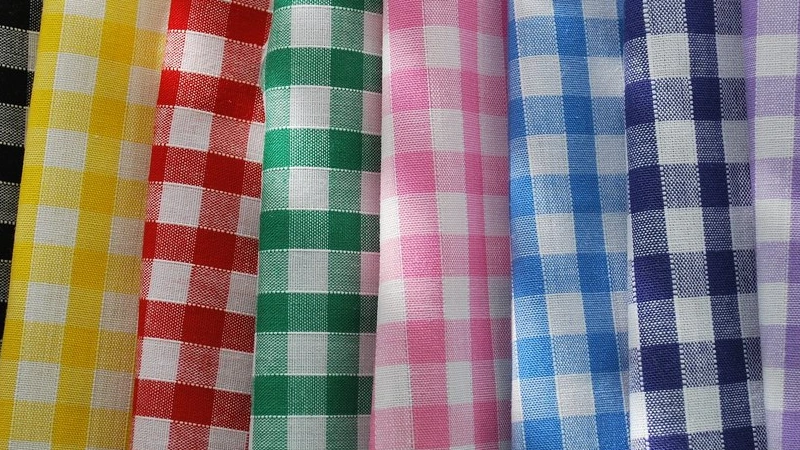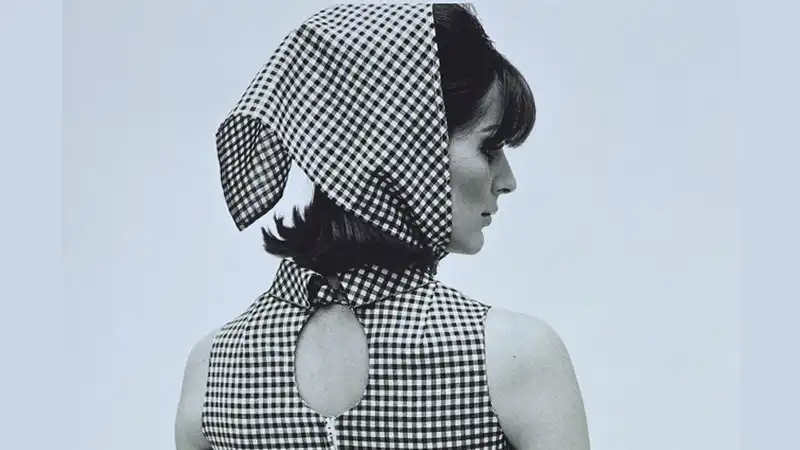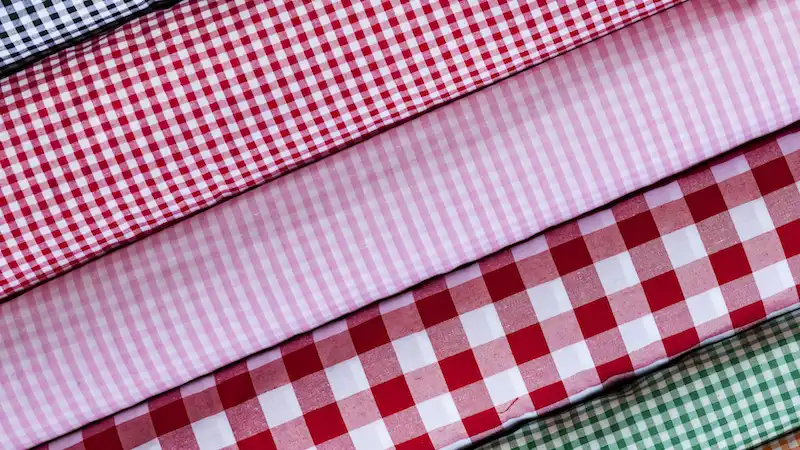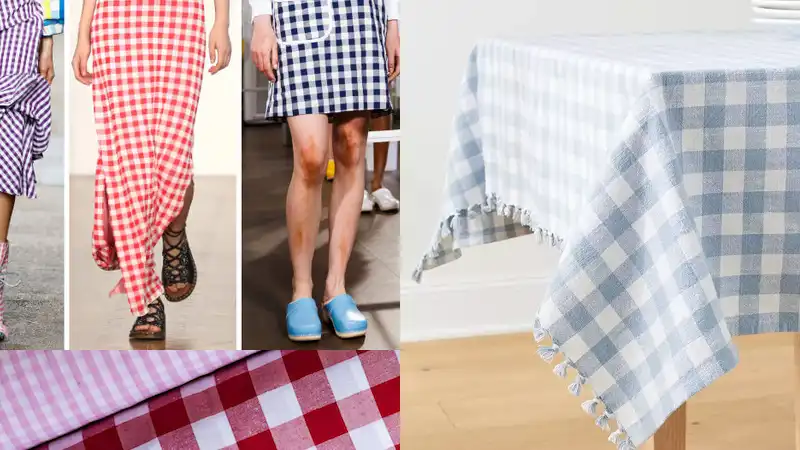Gingham fabric might remind you of summer picnics, charming dresses, or even the iconic blue-and-white dress worn by Dorothy in The Wizard of Oz. But what exactly is gingham, and why has it remained so popular over the years? At its core, gingham is a simple, woven cotton fabric known for its classic checkered pattern. It’s lightweight, breathable, and perfect for everything from fashion to home décor.
In this guide, we’ll dive into everything you need to know about gingham—from its rich history to the best ways to incorporate it into your projects. Whether you’re an experienced crafter or just getting started, you’ll discover how this timeless fabric can bring cozy, vintage charm to any design. Let’s jump in!
What Is Gingham Fabric?

Gingham fabric is a timeless classic, known for its simple checkered pattern created by weaving two different-colored yarns. Made from cotton, it’s soft, breathable, and instantly recognizable with its perfectly even squares.
While the traditional gingham has a white background with colors like red or blue, today you can find it in a rainbow of hues and varying check sizes. Unlike plaid, gingham’s squares are always uniform in size, giving it a crisp, clean look.
The History of Gingham Fabric

Gingham fabric has a fascinating history that spans continents and centuries. While today it’s synonymous with sunny picnics and cozy country vibes, its origins are far older. Gingham is thought to have first appeared in Asia, where it was woven into simple checkered patterns before making its way to Europe.
By the 17th century, it had reached England, where it quickly gained recognition, known for both its practicality and charm. Over time, gingham became associated with simplicity and utility, especially in working-class fashion. In the 19th century, it was widely used for everyday clothing due to its affordability and durability.
It was the perfect fabric for summer, especially for outdoor activities like picnics or country fairs, giving off a laid-back, wholesome vibe. Gingham became closely tied to rural life, offering a breezy, easy feel that was ideal for warmer weather.
By the mid-20th century, gingham experienced a revival in fashion. In the 1950s and 1960s, it shifted from a humble workwear fabric to a chic wardrobe staple. Style icons like Audrey Hepburn and Grace Kelly brought it into the spotlight, making it synonymous with elegance and femininity.
Over the years, gingham has remained relevant, evolving to fit both modern fashion and home décor. Today, it’s still as stylish and timeless as ever.
Key Characteristics of Gingham Fabric
The Checkered Pattern
Gingham fabric is most recognized for its classic checkered pattern, where alternating colored squares create that timeless, charming design. This simple yet eye-catching pattern is made by weaving two different-colored yarns together.
Traditionally, you’ll see gingham with a white background and pops of color—like red, blue, or green—but these days, you can find it in a rainbow of shades and sizes. The clean, crisp lines of the checks make it instantly recognizable and lend that nostalgic, vintage vibe.
Gingham’s Versatility in Material
Gingham is available in a variety of materials, making it versatile for different uses. Cotton gingham is breathable, soft, and great for warmer weather, while polyester versions are a bit more durable and easy to care for.
Blended fabrics offer a nice balance of softness and strength at a more affordable price. Depending on what you plan to use it for, choosing the right material will affect both the texture and the durability of your project, so it’s worth considering.
Reversibility
This means the pattern and color look the same on both sides of the fabric, which gives you more freedom in your projects. Whether you’re crafting a quilt, sewing a shirt, or adding a bit of gingham charm to your home décor, this versatility lets you use either side without worrying about the “right” way.
Durability and Breathability
Gingham is known for its durability and breathability, which is why it’s such a popular choice for summer clothing and home accents. Its breathability makes it super comfortable on warm days, and its durability ensures it holds up well with frequent use.
Compared to other fabrics, like linen or polyester, gingham is strong and can withstand a lot of wear. Whether you’re sewing a breezy dress or adding gingham curtains to your living room, this fabric has staying power and a timeless appeal.
Gingham Weaving Process
Step-by-Step Process
Step 1: Harvesting Cotton
It all starts with the cotton plant. The seeds are carefully removed, leaving behind soft, fluffy cotton fibers. These fibers are the raw material used to create the fabric you love.
Step 2: Dyeing the Cotton Fibers
Once the cotton fibers are ready, they head to the dyeing machine. Here, some fibers are dyed in rich, vibrant colors, while others are left undyed. The undyed fibers make up the crisp white background of the fabric, while the dyed fibers will form the colored checks.
Step 3: Spinning the Cotton into Yarn
The dyed and undyed fibers are spun together into yarn. This step turns the fluffy cotton into strong, twisted threads that are ready for weaving.
Step 4: Weaving the Fabric
The yarns are fed into a weaving machine, where the dyed yarns go in vertically (the warp) and the white yarns go in horizontally (the weft). This weaving pattern forms the classic checkered design, giving gingham its signature look.
Step 5: Washing and Finishing
Once woven, the fabric is washed to soften it and remove any leftover dye. It’s then cut to size and ready to be used in everything from summer dresses to home décor projects.
Why Gingham’s Weaving Technique Matters?
The weaving technique is crucial because it directly impacts the gingham pattern’s sharpness and color. The alternating colors of the dyed and undyed threads create those classic checks, but the weave also affects how the fabric feels and behaves.
The tightness or looseness of the weave determines the texture—this is what gives gingham its signature crisp, yet soft feel. The quality of the dyeing process is also key in ensuring the colors remain vibrant and don’t fade after washing. Without these precise steps, you wouldn’t get that timeless gingham look that’s so beloved!
Woven Gingham vs Printed Gingham
Woven gingham, like the one we just described, is created by weaving two different colors of yarn together. This results in the pattern being embedded right into the fabric, making it part of the fabric’s structure.
On the other hand, printed gingham is made by printing the checkered pattern onto the fabric’s surface. While printed gingham may look similar, it doesn’t have the same depth or durability as woven gingham. Woven gingham often feels a little sturdier and lasts longer, since the pattern won’t fade or wash out as easily.
Types of Gingham Fabric: Material Variations
Cotton Gingham
Cotton gingham is soft, breathable, and super easy to care for. It’s the perfect fabric for warm days when you just want to feel comfy. Plus, it gets softer with every wash, which is a win!
Cotton gingham is perfect for all kinds of projects. It’s great for breezy summer dresses, cute shirts, and even cozy pajama sets. If you’re into DIY home décor, it’s awesome for tablecloths, pillow covers, and quilting projects too.
Polyester Gingham
Polyester gingham is durable, wrinkle-resistant, and super low-maintenance. No need for constant ironing—just toss it in the wash, and you’re good to go.
This fabric is perfect for things that need to stand up to a bit of wear and tear, like outdoor furniture covers, aprons, or everyday clothing. It’s a solid choice for kids’ clothes, too, since it can handle all sorts of messes and spills.
Blended Gingham Fabrics
Blended gingham fabrics mix the softness of cotton with the durability of polyester. It’s the best of both worlds, giving you a fabric that’s comfy yet tough enough to handle pretty much anything.
Blended gingham is perfect for a wide range of items, from casual wear to outdoor essentials like picnic blankets and tote bags. It’s also great for high-traffic areas—think throw pillows or upholstery that needs to be both sturdy and soft.
Sustainable Gingham Fabrics
If you’re all about being eco-friendly, sustainable gingham is your fabric. Made from organic cotton or recycled materials, it’s a fabric that feels good in more ways than one.
Look for labels that say “organic” or “recycled,” and you’ll know you’ve found a sustainable option. You can use sustainable gingham for all the same things as regular gingham—clothing, home décor, or crafting—while feeling good about your impact on the planet.
Gingham Fabric Color Combinations
Traditional Color Pairings
- Red & White: Fresh and country-like, perfect for picnics and summery vibes.
- Blue & White: Calming and serene, making it ideal for casual shirts and cozy home décor.
- Black & White: Sophisticated and chic, great for vintage-style clothing and decorative pillows.
- Green & White: Natural and earthy, perfect for garden-themed items or light spring scarves.
Modern Gingham Colors
- Pastel Gingham: Soft pinks, mint greens, and lilac creating a playful and fresh vibe, popular in dresses, loungewear, and more.
- Neon Accents: Bold colors like electric yellow and hot pink adding an unexpected pop to traditional gingham, especially in home décor.
- Jewel Tones: Deep navy, ruby red, and emerald green bringing an elegant and luxurious twist to gingham, perfect for stylish home accents or fashion pieces.
Seasonal Gingham Colors
Spring and Summer Colors
- Lighter hues like pastels, soft blues, and fresh whites.
- Perfect for airy, breezy styles like cotton shirts, dresses, and summer picnic blankets.
Fall and Winter Colors
- Deeper, muted tones like burgundy, mustard, and forest green.
- Ideal for autumn jackets, comfy flannel shirts, and winter scarves.
- Darker gingham gives a rustic, cozy feel, perfect for chilly months.

What is Gingham Fabric Used For?

Fashion
Gingham is a classic choice for stylish yet laid-back clothing. From breezy summer dresses to comfy shirts and skirts, gingham brings a playful, fresh touch to your wardrobe. It’s also a favorite for accessories like scarves, headbands, and handbags—perfect for adding a pattern pop to any look. Whether you’re dressing up for a picnic or keeping it casual, gingham’s charming checkered design never goes out of style.
Home Décor
Gingham fabric works wonders when it comes to sprucing up your space. You’ll often find it in cozy, farmhouse-style kitchens, where gingham tablecloths and napkins help set the tone for a welcoming, casual atmosphere. It’s also a fantastic way to add some charm to your living room with gingham curtains or throw pillows. The simple yet chic pattern makes gingham an ideal choice for cozy and stylish home décor.
Crafting & DIY Projects
Gingham is a go-to fabric for crafters and DIY enthusiasts. Its versatility is perfect for everything from patchwork quilts to tote bags and aprons. Whether you’re working on a quilting project or making a practical item like a shopping bag, gingham’s easy-to-handle texture makes it the perfect fabric to work with. Plus, the timeless pattern adds a fun touch to any project!
Special Occasions
Gingham is especially popular during the warmer months, perfect for picnics, summer events, and country-themed parties. Its light, breezy feel works great for creating stylish outfits or setting the mood for any gathering. Picture gingham picnic blankets, table settings, or party dresses—whether you’re hosting a casual get-together or celebrating something special, gingham is a fabric that sets the tone.
How to Care for Gingham Fabric?
Taking care of gingham fabric doesn’t have to be complicated. With just a few simple steps, you can keep it looking fresh and vibrant. Whether it’s made of cotton, polyester, or a blend, proper care ensures your gingham stays in tip-top shape. Let’s dive into the best ways to keep it looking great:

Washing and Drying
- Cotton Gingham: Use a gentle wash cycle with warm or cool water to avoid shrinkage.
- Polyester Gingham: Wash on a regular cycle, but always use cool water to maintain fabric durability.
- Blended Gingham: Stick to a gentle wash cycle to protect both cotton and polyester threads.
- Drying: Avoid high heat in the dryer to prevent shrinking or distortion. For wrinkle-free results, air-dry or tumble dry on low heat.
Ironing and Pressing
- Wrinkling After Washing: Gingham, especially cotton or blends, may get wrinkled after washing.
- Ironing Settings: Set your iron to medium heat for cotton or low heat for blends and polyester.
- Iron on Reverse Side: Always iron on the reverse side to protect the pattern and prevent fading.
- Pressing Seams: Take your time pressing seams to ensure they’re neat and flat for a polished, professional look.
- Extra Crispness: Use the steam function or place a damp cloth between the fabric and the iron for an extra crisp finish.
Storing Gingham Fabric
- Folding: Fold your gingham fabric neatly to avoid creases and distortion.
- Avoid Hanging: Don’t hang your gingham fabric for long periods, as it can stretch out of shape.
- Long-Term Storage: Store your gingham in a cool, dry place, away from direct sunlight to prevent fading or color bleeding.
- Dust-Free Storage: Keep your gingham dust-free by storing it in a breathable fabric bag.
- Avoid Plastic Bags: Don’t use plastic bags for storage, as they can trap moisture and lead to mildew.
Restore Gingham Fabric
- Remove Wrinkles: Gently steam the fabric or use a fabric refresher to rehydrate the fibers.
- Restore Color: Wash the gingham with a color-safe detergent or add vinegar to brighten it up.
- Add Softness: Use a fabric softener or wash the fabric on a gentle cycle for extra softness.
Conclusion
Gingham fabric is a timeless classic with a rich history, stretching all the way back to the 17th century. Over the years, it’s become a go-to choice in both fashion and home décor thanks to its unmatched versatility. Whether you’re making a quilt, sewing a summer dress, or sprucing up your home with some gingham charm, the possibilities are endless.
So, why not dive into your next project with some gingham? You’ll find plenty of gorgeous options at F&A Fabric, where you can grab high-quality gingham for crafting, fashion, and home décor. Can’t wait to see what you create!
